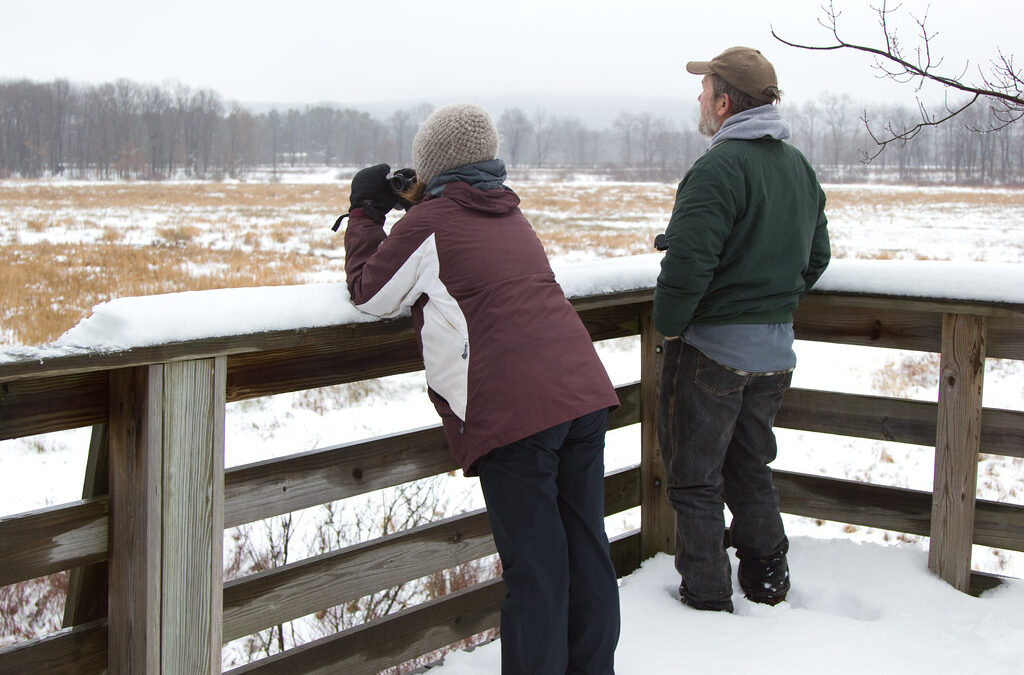By Jeff Tome
Do you ever wonder how we know what we know about animals? Take a simple topic like migration. Many people can tell you that birds migrate south for the winter, but what does that really mean? Where is this place called “south”? The answer is far more complicated than you may expect and ranges from your backyard to the tip of South America.
A good friend worked as a naturalist in Costa Rica one winter, and once showed me her book of Costa Rican birds. It was filled with birds I was familiar with from here. There were Green Herons, Scarlet Tanagers, Hooded Mergansers, Ospreys, Cedar Waxwings, and Rose-breasted Grosbeaks. These birds spend their summers in our area and are often seen at Audubon, but go “south” in the winter. Some end up in Costa Rica, others end up in other places.
I like to think of these birds as the birds of summer. They migrate to our area for the long hot days of summer to take advantage of the long days and abundant insects to feed their young. They migrate south into the hot equator regions and further south to take advantage of the summer in South America.

This makes intrinsic sense to most people. What animal would huddle in the cold and snow if it had the option for a hot vacation? The flip side of that is that an animal that migrates over 1,000 miles twice a year has a brutally long trip that requires tremendous strength, endurance, and sense of direction.
The tidbit of information that most people don’t realize is that this region of New York and Pennsylvania is also part of the “south” that birds migrate to each winter. Backyard birdfeeders fill with birds from the far north, where the temperatures can be much, much colder than the temperatures here. Tree Sparrows, juncos, and White-throated Sparrows are some of the many birds that take advantage of the comparatively warmer winters here compared to the far north where they spend the rest of the year.
There are many ways that people track where birds go. Bird banding, where each bird is fitted with a tiny metal bracelet that has a unique identification number, has been going on for generations. Scientists hope to catch a bird multiple times to learn where they go and how they migrate. Newer technology has allowed scientists to put tiny solar powered GPS transmitters on larger birds to follow their migration in real time.
One of the oldest ways to track where birds end up and how many are out there is the Christmas Bird Count. This annual count takes place in a 10-mile-wide circle around cities and towns across the United States, including in Jamestown, Warren and Dunkirk. Each year, dozens of people venture out to find, identify, and count birds in December. Some travel the same routes that have been walked or driven for 50 years. Others count at their backyard feeders. The numbers are all tallied together and reported to the Cornell Lab of Ornithology, which compiles the data into a report on where birds are being found and how many there are.

Christmas Bird Count data can be used for lots of things. It shows that American Robins prefer to be in areas with five inches or less of snow. It shows where birds end up during irruptions, when northern birds abruptly migrate south every few years. This year may be another irruption year for Snowy Owls, which are being reported in open areas in surrounding areas. The Christmas Bird Count will help scientists understand where those birds end up this winter.
Volunteers who like to (or would like to learn how to) identify and count birds are needed for this year’s Christmas Bird Count. The Warren Christmas Bird Count will take place on December 18. Contact Don Watts at (814) 723-9125 if you would like to participate. The Jamestown Christmas Bird Count will take place on December 19. Contact Bill Seleen at (716) 386-3209. These Christmas Bird Count volunteers coordinate where people go to make sure that the entire count circle is covered.
The Christmas Bird Count is a great way to expand your ability to find and identify local birds, while also contributing to a scientific survey of bird populations that goes back to the 1940’s in our area. The people who love birds and count them each year are part of a birding community that would love to welcome you to join them.
Audubon Community Nature Center builds and nurtures connections between people and nature. ACNC is located just east of Route 62 between Warren and Jamestown. The trails are open from dawn to dusk as is Liberty, the Bald Eagle. The Nature Center is open, including restrooms, the Blue Heron Gift Shop, Indoor Nature Play Area and most exhibits. More information can be found online at auduboncnc.org or by calling (716) 569-2345.


Recent Comments